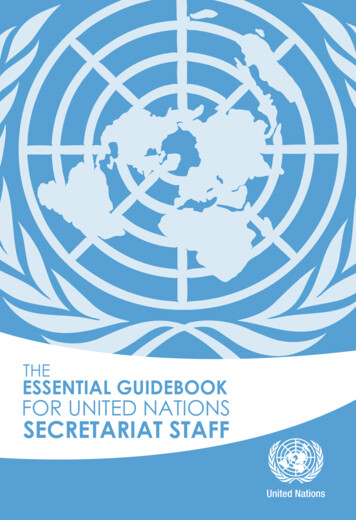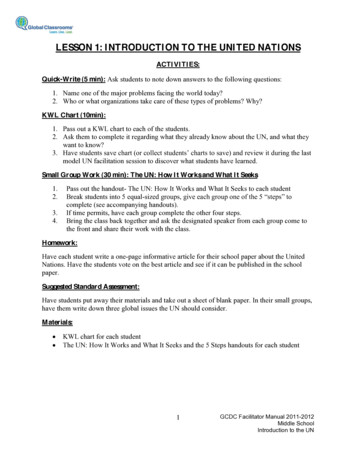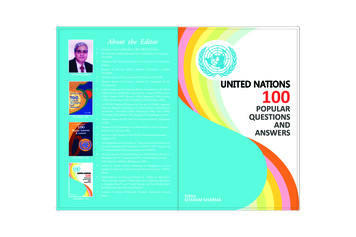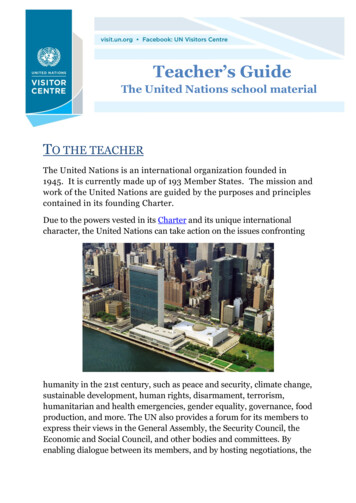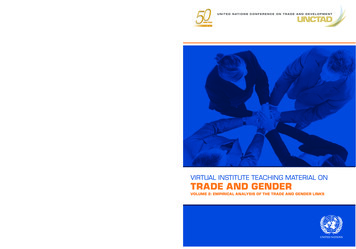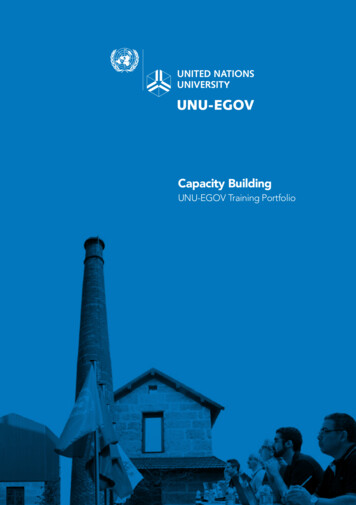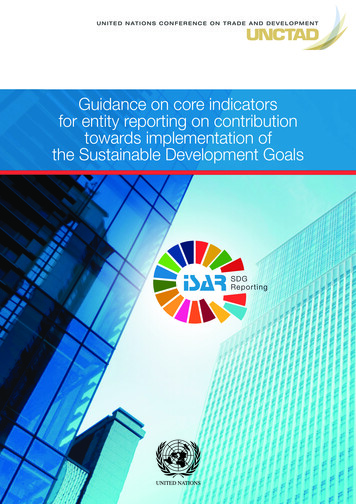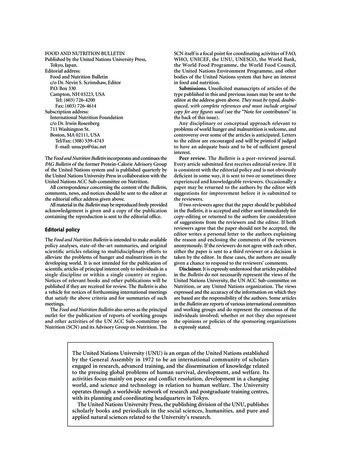
Transcription
(1,1) -2- FNB V23N4 supplement cover 10/18/02, 10:28:03 AMFOOD AND NUTRITION BULLETINPublished by the United Nations University Press,Tokyo, Japan.Editorial address:Food and Nutrition Bulletinc/o Dr. Nevin S. Scrimshaw, EditorP.O. Box 330Campton, NH 03223, USATel: (603) 726-4200Fax: (603) 726-4614Subscription address:International Nutrition Foundationc/o Dr. Irwin Rosenberg711 Washington St.Boston, MA 02111, USATel/Fax: (508) 539-4743E-mail: unucpo@tiac.netThe Food and Nutrition Bulletin incorporates and continues thePAG Bulletin of the former Protein-Calorie Advisory Groupof the United Nations system and is published quarterly bythe United Nations University Press in collaboration with theUnited Nations ACC Sub-committee on Nutrition.All correspondence concerning the content of the Bulletin,comments, news, and notices should be sent to the editor atthe editorial office address given above.All material in the Bulletin may be reproduced freely providedacknowledgement is given and a copy of the publicationcontaining the reproduction is sent to the editorial office.Editorial policyThe Food and Nutrition Bulletin is intended to make availablepolicy analyses, state-of-the-art summaries, and originalscientific articles relating to multidisciplinary efforts toalleviate the problems of hunger and malnutrition in thedeveloping world. It is not intended for the publication ofscientific articles of principal interest only to individuals in asingle discipline or within a single country or region.Notices of relevant books and other publications will bepublished if they are received for review. The Bulletin is alsoa vehicle for notices of forthcoming international meetingsthat satisfy the above criteria and for summaries of suchmeetings.The Food and Nutrition Bulletin also serves as the principaloutlet for the publication of reports of working groupsand other activities of the UN ACC Sub-committee onNutrition (SCN) and its Advisory Group on Nutrition. TheSCN itself is a focal point for coordinating activities of FAO,WHO, UNICEF, the UNU, UNESCO, the World Bank,the World Food Programme, the World Food Council,the United Nations Environment Programme, and otherbodies of the United Nations system that have an interestin food and nutrition.Submissions. Unsolicited manuscripts of articles of thetype published in this and previous issues may be sent to theeditor at the address given above. They must be typed, doublespaced, with complete references and must include originalcopy for any figures used (see the “Note for contributors” inthe back of this issue).Any disciplinary or conceptual approach relevant toproblems of world hunger and malnutrition is welcome, andcontroversy over some of the articles is anticipated. Lettersto the editor are encouraged and will be printed if judgedto have an adequate basis and to be of sufficient generalinterest.Peer review. The Bulletin is a peer-reviewed journal.Every article submitted first receives editorial review. If itis consistent with the editorial policy and is not obviouslydeficient in some way, it is sent to two or sometimes threeexperienced and knowledgeable reviewers. Occasionally apaper may be returned to the authors by the editor withsuggestions for improvement before it is submitted tothe reviewers.If two reviewers agree that the paper should be publishedin the Bulletin, it is accepted and either sent immediately forcopy-editing or returned to the authors for considerationof suggestions from the reviewers and the editor. If bothreviewers agree that the paper should not be accepted, theeditor writes a personal letter to the authors explainingthe reason and enclosing the comments of the reviewersanonymously. If the reviewers do not agree with each other,either the paper is sent to a third reviewer or a decision istaken by the editor. In these cases, the authors are usuallygiven a chance to respond to the reviewers’ comments.Disclaimer. It is expressly understood that articles publishedin the Bulletin do not necessarily represent the views of theUnited Nations University, the UN ACC Sub-committee onNutrition, or any United Nations organization. The viewsexpressed and the accuracy of the information on which theyare based are the responsibility of the authors. Some articlesin the Bulletin are reports of various international committeesand working groups and do represent the consensus of theindividuals involved; whether or not they also representthe opinions or policies of the sponsoring organizationsis expressly stated.The United Nations University (UNU) is an organ of the United Nations establishedby the General Assembly in 1972 to be an international community of scholarsengaged in research, advanced training, and the dissemination of knowledge relatedto the pressing global problems of human survival, development, and welfare. Itsactivities focus mainly on peace and conflict resolution, development in a changingworld, and science and technology in relation to human welfare. The Universityoperates through a worldwide network of research and postgraduate training centres,with its planning and coordinating headquarters in Tokyo.The United Nations University Press, the publishing division of the UNU, publishesscholarly books and periodicals in the social sciences, humanities, and pure andapplied natural sciences related to the University’s research.
ContentsThe Positive Deviance Approach to Improve Health Outcomes: Experience andEvidence from the FieldThe positive deviance approach to improve health outcomes: experience and evidence fromthe field—Preface—David R. Marsh and Dirk G. Schroeder. 3Positive deviant behavior and nutrition education—Warren L. Berggren and Joe D. Wray . 7Ti Foyer (hearth) community-based nutrition activities informed by the positive deviance approachin Leogane, Haiti: A programmatic description—K. Bolles, C. Speraw, G. Berggren,and J. G. Lafontant . 9Sustained positive deviant child care practices and their effects on child growth in Viet Nam—U. A. T. Mackintosh, D. R. Marsh, and D. G. Schroeder. 16Comparison of a positive deviant inquiry with a case-control study to identify factors associated withnutritional status among Afghan refugee children in Pakistan—K. Lapping, D. Schroeder,D. Marsh, R. Albalak, and M. Z.Jabarkhil . 26Design of a prospective, randomized evaluation of an integrated nutrition program in rural Viet Nam—D. R. Marsh, H. Pachón, D. G. Schroeder, T. T. Ha, K. Dearden, T. T. Lang, N. D. Hien, D. A. Tuan,T. D. Thach, and D. Claussenius . 34Weighing Vietnamese children: How accurate are child weights adjusted for estimates of clothing weight?—T. Tuan, D. R. Marsh, T. T. Ha, D. G. Schroeder, T. D. Thach, V. M. Dung, and N. T. Huong . 45An integrated child nutrition intervention improved growth of younger, more malnourished childrenin northern Viet Nam—D. G. Schroeder, H. Pachón, K. A. Dearden, T. T. Ha, T. T. Lang,and D. R. Marsh. 50Effect of an integrated child nutrition intervention on the complementary food intake of young childrenin rural north Viet Nam—H. Pachón, D. G. Schroeder, D. R. Marsh, K. A. Dearden, T. T. Ha,and T. T. Lang . 59Effect of an integrated nutrition program on child morbidity due to respiratory infection and diarrheain northern Viet Nam—T. Sripaipan, D. G. Schroeder, D. R. Marsh, H. Pachón, K. A. Dearden,T. T. Ha, and T. T. Lang . 67Implementation of nutrition education and rehabilitation programs (NERPs) in Viet Nam—V. C. Dickey, H. Pachón, D. R. Marsh, T. T. Lang, D. R. Claussenius, K. A. Dearden, T. T. Ha,and D. G. Schroeder . 75Empowerment in Rural Viet Nam: Exploring changes in mothers and health volunteers in the contextof an integrated nutrition project—J. L. Hendrickson, K. Dearden, H. Pachón, N. H. An,D. G. Schroeder, and D. R. Marsh. 83Caregiver styles of feeding and child acceptance of food in rural Viet Nam—P. B. Ha, M.E. Bentley,H. Pachón, T. Sripaipan, L. E. Caulfield, D. R. Marsh, and D. G. Schroeder . 92Work outside the home is the primary barrier to exclusive breastfeeding in rural Viet Nam: insights frommothers who exclusively breastfed and worked—K. A. Dearden, L. N. Quan, M. Do, D. R. Marsh,H. Pachón, D. G. Schroeder, and T. T. Lang . 99Identification of model newborn care practices through a positive deviance inquiry to guidebehavior-change interventions in Haripur, Pakistan—D. R. Marsh, M. Sternin, R. Khadduri,T. Ihsan, R. Nazir, A. Bari, and K. Lapping . 107What influences health behavior? Learning from caregivers of young children in Viet Nam—K. A. Dearden, L. N. Quan, M. Do, D. R. Marsh, D. G. Schroeder, H. Pachón, and T. T. Lang. 117The positive deviance approach: Challenges and opportunities for the future—K. Lapping,D. R. Marsh, J. Rosenbaum, E. Swedberg, J. Sternin, M. Sternin, and D. G. Schroeder . 128
Food and Nutrition BulletinEditor: Dr. Nevin S. ScrimshawManaging Editor: Ms. Edwina B. MurrayManuscripts Editor: Mr. Jonathan HarringtonAssociate Editor—Clinical and Human Nutrition:Dr. Irwin Rosenberg, Director, USDA Human Nutrition Research Centeron Aging, Tufts University, Boston, Mass., USAAssociate Editor—Food Policy and Agriculture:Dr. Suresh Babu, International Food Policy Research Institute,Washington, DC, USAEditorial Board:Dr. Ricardo Bressani, Institute de Investigaciones, Universidad del Vallede Guatemala, Guatemala City, GuatemalaDr. Hernán Delgado, Director, Institute of Nutrition of Central Americaand Panama (INCAP), Guatemala City, GuatemalaDr. Cutberto Garza, Professor, Division of Nutritional Sciences, CornellUniversity, Ithaca, N.Y., USADr. Joseph Hautvast, Secretary General, IUNS, Department of HumanNutrition, Agricultural University, Wageningen, NetherlandsDr. Peter Pellett, Professor, Department of Food Science and Nutrition,University of Massachusetts, Amherst, Mass., USADr. Zewdie Wolde-Gabreil, Director, Ethiopian Nutrition Institute, AddisAbaba, EthiopiaDr. Aree Valyasevi, Professor and Institute Consultant, Mahidol University,Bangkok, ThailandFood and Nutrition Bulletin, vol. 23, no. 4 (supplement) The United Nations University, 2002United Nations University PressThe United Nations University53-70 Jingumae 5-chome, Shibuya-ku, Tokyo 150-8925, JapanTel.: (03) 3499-2811Fax: (03) 3406-7345E-mail: mbox@hq.unu.eduISSN 0379-5721Design and Production by Desktop Publishing & Design Co., Newton, MA USAPrinted on acid-free paper by Webcom Ltd., Toronto, ON Canada
The positive deviance approach to improve healthoutcomes: experience and evidence from thefield—PrefaceDavid R. Marsh and Dirk G. SchroederPositive deviance programmingPositive deviance (PD) refers to a phenomenon thatexists in many resource-poor communities, that is,the finding that a few individuals and families employuncommon, beneficial practices that allow them andtheir children to have better health as compared to theirsimilarly impoverished neighbors. These PD behaviorsare likely to be affordable, acceptable, and sustainableby the wider community because their peers are alreadypracticing them.Programmers who use the PD approach for improving health outcomes work with communities to determine community norms regarding a specific, desirableoutcome (e.g., good child growth), to identify a few(usually four to six) individuals who have achievedthe good outcome (i.e., not the “normal” or expectedoutcome) despite high risk, to conduct a PD inquiry tolearn from these PD individuals the behaviors that arelikely to explain the good outcome and be feasible fortheir neighbors, and to design behavior change interventions to enable adoption of these new PD behaviors.Most PD interventions thus far have targeted childhoodmalnutrition and have provided communal opportunities to observe and practice new behaviors until skillsare mastered (e.g., hearth settings).In the early 1990s, a series of small-scale studiessuggested that programs based on the PD approachwere efficacious and well accepted. During the mid- tolate-1990s, some of these programs were scaled-up,reaching millions of people in developing countries.At the same time, programmers in disciplines outsideof nutrition were anxious to learn how PD could beadapted to new technical areas.Because international community developmentworkers sought to invest significant effort in furthering the PD approach, we felt that the time was rightDavid R. Marsh is affiliated with Save the ChildrenFederation/US in Westport, Conn., USA. Dirk G. Schroederis affiliated with the Rollins School of Public Health, EmoryUniversity in Atlanta, Ga., USA.to evaluate the validity and sustainability of the PDapproach, to conduct a rigorous evaluation of a PDinformed, large-scale field intervention, to describesome novel applications of PD currently underway,and to present the theoretical challenges and opportunities for more extensive use of PD. As veteran usersand students of the PD approach, this supplement isthe result of this effort.Supplement contentThis supplement has three sections that trace the evolution of our program learning. The Background sectioncommences with a brief overview of the history of PD[1] and a detailed description of an on-going application in Haiti [2]. The sustainability study [3] sparkedmuch of what follows. The first author on this paper revisited former PD program communes in Viet Nam twoyears after a Save the Children program based on PDhad ceased. She found that former program childrenand their younger siblings born after the project stoppedwere better nourished than counterpart children incommunes that never had the program. Moreover,former program mothers reported applying PD practices learned in the program to the younger children.It appeared that the promise of the PD approach foracceptability, affordability, and sustainability had beensuccessful. Meanwhile Lapping et al. [4] compared thefindings from a small sample PD inquiry to a largesample case control study in the same population ofAfghan refugees in Pakistan. The case control studyconfirmed many of the PD inquiry findings, satisfyingus that the PD methods were sound. Thus, armed withexciting impact data and methodological corroboration, we sought and acquired funding from the USAIDLINKAGES project to conduct a rigorous evaluationof a large-scale implementation of the PD approach tobetter understand “why and how PD works.” This socalled ViSION (Viet Nam study to improve outcomesin nutrition) project is the basis for the next section ofthis supplement.Food and Nutrition Bulletin, vol. 23, no. 4 (supplement) 2002, The United Nations University.3
4D. R. Marsh and D. G. SchroederThe section on prospective evaluation is devotedto papers reporting a prospective, longitudinal,randomized evaluation of one iteration of Save theChildren’s community empowerment and nutritionprogram (CENP) in northern Viet Nam. CENP uses aPD approach and aims to sustainably rehabilitate malnourished children and prevent malnutrition amongfuture community children. Rigorous effectivenessevaluations (i.e., under real field conditions, as opposedto efficacy evaluations with tightly controlled conditions) are rare, and we believe that the findings willinterest many in the international health community,above and beyond their interest in PD.We planned our research, analysis, and documentation in accordance with UNICEF’s conceptual framework for child survival [5] (fig. 1). A key objective ofour analysis was to document through which causalpathway PD-improved behaviors led to better growth.In earlier work, we often referred to the mechanismsthat led from the PD approach to better growth as a“black box.” Section two of this supplement is ourattempt to begin to lift the lid off this box.We start the section with a detailed methods paper[6] that describes a complex integrated program andthe evaluation research design. Tuan et al. [7] thenreport on innovative methods to accurately calculatethe weight of clothed children in different seasons inViet Nam. After these methodological papers, we workfrom top-to-bottom within the UNICEF conceptualframework. The paper by Schroeder et al.[8] reportsthe impact of the CENP program on growth, thefinal outcome for the program (i.e., mortality was notmeasured). The next two papers present analyses of diet[9] and morbidity [10]. Moving one-level down theframework, Dickey et al. [11] provide an evaluation ofthe central CENP intervention, the “hearth sessions,”hamlet-level, daily gatherings of mothers and theirmalnourished children learning to practice and adoptnew feeding, health, and childcare practices under thesupervision of trained local volunteers. Hendricksonet al. [12] used qualitative methods to longitudinallystudy empowerment and selected enablers of behaviorchange among health volunteers and mothers. Finally,Ha et al. [13] provide insights into rural Vietnamesefeeding styles through preliminary analyses of a sampleof directly observed and videotaped feeding episodes.In the last section, new directions, we report on newexperience and new thinking. Dearden et al. [14, 15],report two related LINKAGES-funded studies in VietNam. The first, a large-sample PD inquiry, confrontsthe challenge of poor exclusive breastfeeding practicesin rural Viet Nam and identifies PD women and PDstrategies to inform a behavior change intervention [14].The second reports the use of elicitation procedures tosystematically study behavioral determinants critical forsingle behavioral outcomes like breastfeeding as compared to a nutritional status outcome for which a hostof behaviors may impinge [15]. Marsh et al. [16] thenreport a new application of a PD inquiry for improvednewborn care in Pakistan. Finally, Lapping et al. [17]complete the supplement, teasing out lessons learned,sharing even fresher PD applications in progress, challenging researchers to tighten up the theoretical underpinnings of PD, and proposing some next steps.MortalitySchroederet al. [8]MalnutritionPachónet al. [8]Sripaipanet al. [8]DietDickeyet al. [8]InfectionHendricksonet al. [8]FoodCareHaet al. [8]Tuanet al. [8]HealthservicesFIG. 1. Modified UNICEF conceptual framework of child health andsurvival (unshaded ovals indicate supplement papers)
PrefaceConclusionThe authors of these papers neither discovered PD norcreatively applied PD to programs. The credit for thisgoes to a generation of international health thinkersand doers, including Joe Wray, Marian Zeitlin, Gretchenand Warren Berggren, and Jerry and Monique Sternin,among others. Our task, rather, was to shed light on thehow and why of PD-informed programming. In addition to the individuals just listed, heartfelt acknowledgement also goes to USAID and the LINKAGESproject for financially and technically supporting theresearch; to Hanoi’s Research and Training Center forCommunity Development for their outstanding fieldresearch team; and to the John Grant Fund to promotechild survival, the Ford Foundation, and Save the Children Federation/US for supporting the documentationand publication of these findings. Three individualsdeserve special recognition, without whom the ViSIONproject would not have succeeded: Helena Pachón,5co-principal investigator; Kirk Dearden, co-principalinvestigator and LINKAGES evaluation specialist; andTran Thu Ha, scientific coordinator.The PD story is far from complete. In many wayswe are left with more questions than we started with;we challenge researchers to continue to investigate theunknowns regarding positive deviance. We encourageprogrammers to apply what we have learned about PDin new and creative ways and to share these experienceswith us and among themselves. This volume is dedicated to the field workers and families who will benefitfrom more effective strategies for them to improve theirown health.David R. MarshWestport, ConnecticutEmail: dmarsh@savechildren.orgDirk G. SchroederAtlanta, GeorgiaEmail: schroeder@drtango.comReferences1. Berggren W, Wray J. Positive deviant behavior and nutrition education. Food Nutr Bull 2002;23(4 Suppl): 7–8.2. Bolles K, Speraw C, Bergg ren G, Lafontant JG. Ti Foyer(hearth) community-based nutrition activities informedby the positive deviance approach in Leogane, Haiti: aprogrammatic description. Food Nutr Bull 2002;23(4 Suppl):9–15.3. Mackintosh UAT, Marsh DR, Schroeder DG. Sustainedpositive deviant child care practices and their effectson child growth in Viet Nam. Food Nutr Bull 2002;23(4 Suppl):16–25.4. Lapping K, Schroeder DG, Marsh DR, Albalak R,Jabarkhil MZ. Comparison of a positive deviant inquirywith a case-control study to identify factors associatedwith nutritional status among Afghan refugee childrenin Pakistan. Food Nutr Bull 2002;23(4 Suppl):26–33.5. UNICEF. Strategy for improved nutrition of childrenand women in developing countries. UNICEF PolicyReview 1990-XXX (E/CEF/19990/L.6). New York:UNICEF, 1990.6. Marsh DR, Pachón H, Schroeder DG, Ha TT, DeardenKA, Lang TT, Hien ND, Tuan DA, Thach TD, Claussenius DR. Design of a prospective, randomized evaluationof an integrated nutrition program in rural Viet Nam.Food Nutr Bull 2002;23(4 Suppl):34–44.7. Tuan T, Marsh DR, Ha TT, Schroeder DG, Thach TD,Dung VM, Huong NT. Weighing Vietnamese children:How accurate are child weights adjusted for estimatesof clothing weight? Food Nutr Bull 2002;23(4 Suppl):45–49.8. Schroeder DG, Pachón H, Dearden KA, Ha TT, LangTT, Marsh DR. An integrated child nutrition intervention improved growth of younger, more malnourishedchildren in northern Viet Nam. Food Nutr Bull 2002;23(4 Suppl):50–58.9. Pachón H, Schroeder DG, Marsh DR, Dearden KA,Ha TT, Lang TT. Effect of an integrated child nutrition intervention on the complementary food intakeof young children in rural north Viet Nam. Food NutrBull 2002;23(4 Suppl):59–66.10. Sripaipan T, Schroeder DG, Marsh DR, Pachón H,Dearden KA, Ha TT, Lang TT. Effect of an integratednutrition program on child morbidity due to diarrheaand respiratory infection in northern Viet Nam. FoodNutr Bull 2002;23(4 Suppl):67–74.11. Dickey VC, Pachón H, Marsh DR, Lang TT, ClausseniusDR, Dearden KA, Ha TT, Schroeder DG. Implementation of nutrition education and rehabilitation programs(NERPs) in Viet Nam. Food Nutr Bull 2002;23(4 Suppl):75–82.12. Hendrickson JL, Dearden KA, Pachón H, An NH,Schroeder DG, Marsh DR. Empowerment in ruralVietnam: exploring changes in mothers and health volunteers in the context of an integrated nutrition project.Food Nutr Bull 2002;23(4 Suppl):83–91.13. Ha PB, Bentley ME, Pachón H, Sripaipan T, Caulfield LE,Schroeder DG. Caregiver styles of child feeding in ruralViet Nam. Food Nutr Bull 2002;23(4 Suppl):92–97.14. Dearden KA, Quan LN, Do M, Marsh DR, Pachón H,Schroeder DG, Lang TT. Work outside the home is theprimary barrier to exclusive breastfeeding in rural VietNam: insights from mothers who exclusively breastfedand worked. Food Nutr Bull 2002;23(4 Suppl):99–106.15. Dearden KA, Quan LN, Do M, Marsh DR, SchroederDG, Pachón H, Lang TT. What influences health behavior? Learning from caregivers of young children in VietNam. Food Nutr Bull 2002;23(4 Suppl):117–127.16. Marsh DR, Sternin M, Khadduri R, Ihsan T, Nazir R,Bari A, Lapping K. Identification of model newborn carepractices through a positive deviance inquiry to guide
6behavior-change interventions in Haripur, Pakistan.Food Nutr Bull 2002;23(4 Suppl):107–116.17. Lapping K, Marsh DR, Swedberg E, Sternin J, Sternin M,D. R. Marsh and D. G. SchroederSchroeder DG. The positive deviance approach: challenges and opportunities for the future. Food Nutr Bull2002;23(4 Suppl):128–135.
Positive deviant behavior and nutrition educationWarren L. Berggren and Joe D. WrayDr. Joe D. Wray, in his 1972 Tropical Pediatrics editorial, asked, “Can we learn from successful mothers?”His question had not previously appeared in a scientific journal, possibly because it may have embarrassedmany professional scientific nutrition teachers to consider it seriously. Nutritional surveys often discoverwell-nourished children in poor families that inhabitvillages where nearly all children are both poor andmalnourished. Such well-nourished children are evidence that some mothers, despite poverty, can feed andcare for their children successfully. Wray pointed outthat, in order to teach useful child-care and feedingpractices to poor mothers, we need to learn what local,successful, poor mothers are practicing [1].No one published any answers to Wray’s question,but many of us who read it looked for successful mothers and listened to them. In 1976, Sam Wishik andSusan Van der Vynckt of Columbia University proposeda project to identify “positive deviant” (PD) familiesin order to observe their care and feeding behaviors.They intended to teach those behaviors to mothersof malnourished children and, finally, to evaluate theteaching’s impact on children’s nutritional status [2].Without referring to Wray’s editorial, Wishik andVan der Vynckt characterized the families as “positivedeviants” because they deviated from their population’snorm in that their children were in the upper quartileof weight-for-age and height-for-age, and their deviation from the norm was in an upward, or “positive,”direction. Wishik and Van der Vynckt thus gave “successful mothers” an academically erudite title. They alsodescribed methods to identify PD families, study theirbehavior, and teach PD feeding practices throughoutthe population. There is no published report of theirproject’s implementation or its achievements.Fourteen years later, in 1990, Zeitlin et al. publishedWarren L. Berggren is affiliated with the Department ofTropical Medicine, Tulane University School of Public Healthand Tropical Medicine in New Orleans, La., USA. Joe D. Wrayis an Emeritus Professor at Columbia University School ofPublic Health in New York.extensive observations of PD behavior among Yorubaand Javanese families and their relation to children’snutritional status [3]. Their work, and a subsequentpublication by Shekar et al. in 1992 [4], made the studyof mothers’ PD behavior and its impact on childhoodnutrition a respectable category for academic and operational research. Today, there are published reports ofchildren’s improved nutritional status in populationsthat have learned to practice the care and feedingbehaviors of PD mothers [5, 6]. Wray’s question hasbeen answered affirmatively.Finding PD mothers and identifying the behaviorsthat make them successful is a “rapid assessment” procedure rather than a survey [7]. An assessor locates PDmothers by weighing a population’s children. The assessor selects, from among children weighing in the top10% or 25% of the weight-for-age distribution, thosewhose families’ resources are meager. The assessor nextinterviews the selected children’s mothers to identifyany caring or feeding practices that distinguish themfrom mothers of malnourished children.The behaviors vary with season, food prices, familyillness, and unforeseen political events that furtherconstrain resources and options. Assessment of PDbehavior, called a “positive deviant inquiry” (PDI) [5],should therefore be done in each new community andwith each important change in season. Programs canquickly lose their effectiveness by neglecting to repeattheir PDIs appropriately.It is important that nutrition teachers learn the PDbehaviors and even more important that mothers ofmalnourished children begin to practice them as soonas possible. Their learning process must include discovering the appropriate information, practicing the PDbehaviors under supervision, and experiencing proofthat their children recover their health as they are fedand cared for appropriately.Current learning programs are called “nutritionaleducation and rehabilitation projects,” “hearths,” or avariety of other names. All of them induce mothers torehabilitate their own and their neighbors’ malnourished children in their own homes or similar settings,Food and Nutrition Bulletin, vol. 23, no. 4 (supplement) 2002, The United Nations University.7
8using foods and feeding and caring behaviors learnedfrom local PD mothers. Mothers’ performance of thePD behaviors should be sustained over a period of atleast four weeks so that mothers acquire them as habitsW. L. Berggren and J. D. Wray[8]. Learning programs are most successful when allparticipants are valued, respected, and especiallyaffirmed when they practice the PD behaviors andtheir children regain their health.References1. Wray JD. Can we learn from successful mo
by the General Assembly in 1972 to be an international community of scholars engaged in research, advanced training, and the dissemination of knowledge related to the pressing global problems of human survival, development, and welfare. Its activities focus mainly on peace and conflict resolution, development in a changing


